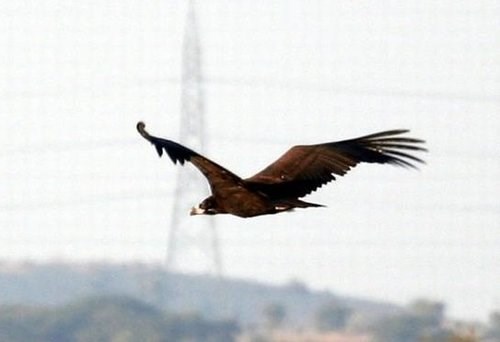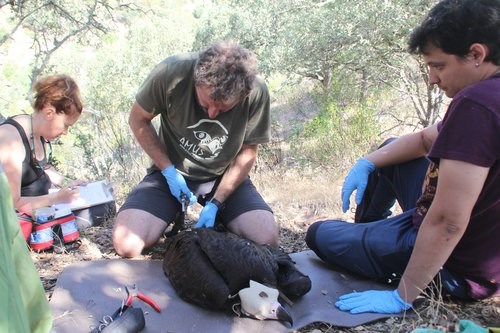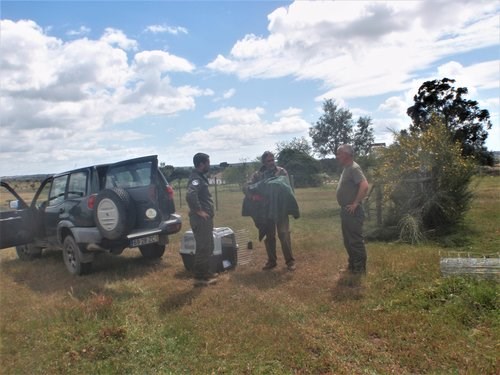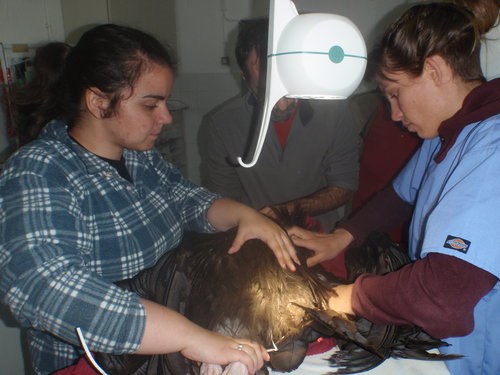Power Lines Remain a Threat for the Endangered Cinereous Vulture
Posted on in In the Field by Alfonso Godino, Research Associate

The cinereous vulture (Aegypius monachus) is an endangered species in Portugal and in the European Union. After the extinction as a breeding species in Portugal during the 1970´s, we observed a few pairs starting to breed in Tejo International National Park in 2010.
After almost a decade after the recolonization, no studies were implemented on this colony with the exception of the annual breeding population census.
Due to the lack of information about the ecology of this colony, in 2018, Hawk Mountain Sanctuary collaborated with the Tejo International N. P., and joined efforts with the Portuguese National Agency for Nature Conservation, the electric company ENDESA, and the Toxicology Department of the Veterinary University of Murcia to study the cinereous vulture in the main colony of Portugal.
The main goals of this project are to study the juvenile dispersion and to identify the limiting factors and threats affecting to this group of the population.

To achieve these goals, in 2018, all the nestlings in the colony (8) were equipped with GPS-GSM transmitters, six of them were tagged in the nest and other two were sent to the wildlife rescue centre before fledging (one because the collapse of the nest and the second one due to the beginning of a starvation process), but both were released later after recovery.
Movements during the first year of tracking showed all the juveniles stayed mainly in the colony and nearby surroundings, with some excursions of 80-100 km away from the colony. During one of these excursions, one of the vultures showed, thanks to the information sent by the transmitter, small movement and no flight behaviour.
After detecting this lack of movements, on April 10, staff of Tejo International N. P. and Serra de São Mamede N. P., another protected area close where the vulture was detected, went to the location of the last positions sent by the transmitter.
The place, 70 km southwest of the colony where the vulture was tagged, is an area of Mediterranean open forest and extensive livestock, a perfect place for a juvenile cinereous vulture searching for food. Unfortunately, several power lines cross the area.

After a few minutes searching for the vulture, the team found the bird, and it was sent to the nearest wildlife rescue centre close to the Tejo International N.P. The first vet check showed a dislocation or luxation on the right wing, affecting some tendons, probably caused by an impact. Due to this diagnostic and the urgent need for a surgical intervention, the vulture was sent to the Veterinary University of Trás-os-Montes e Alto Douro (UTAD).

The injured cinereous vulture is still at the University and waiting for a diagnostic to start the rehabilitation process with physiotherapy in the rescue centre. Only after this period of therapy will we be able to determine if this vulture could released back to the wild or if it must keep in captivity for all its life.
All signs point to a collision with a wire as the origin of this wing injury, and the presence of several power lines in the area where the vulture was found, none of which have been marked to reduce birds´ collision, lead us to think that this is the cause of this unfortunate incident.
Electrocution and collision with power lines is an important threat for raptors´ conservation in many areas all around the world, despite the effort of public bodies, wildlife conservation NGOs, and electric companies to minimize this threat.
But many times, the incidence of raptor collision and electrocution by power lines is underestimated, because there are no records due to the lack of monitoring. For this reason, it is very important to use new technologies and to equip raptors with GPS devices with the goal to detect potential threats.

In this case, the information supplied by the GPS-GSM units provided by Hawk Mountain Sanctuary, and especially the combination of coordinates giving us the bird’s location and the information on movement speed provided by the device, allowed us to detect very quickly that the bird was not flying. As a result, we could react in time to recover this bird while it was still alive. If this vulture was not equipped with the GPS, it is highly probable that nobody would have known of the collision with power lines and the vulture would have died.
There are still six other nestlings equipped during 2018 with GPS and in 2019, and another eight new cinereous vultures of the Tejo International N. P. colony will be tagged with GPS units thanks to the HMS support. The information provided during this first year of monitoring and the future information gathered for these vultures will be an essential tool to identify and prevent threats on this endangered population, and it will increase our understanding about the juvenile dispersion and survival in this colony.